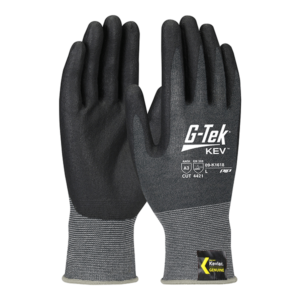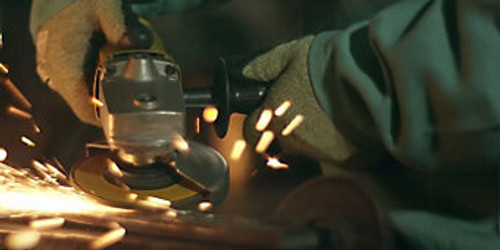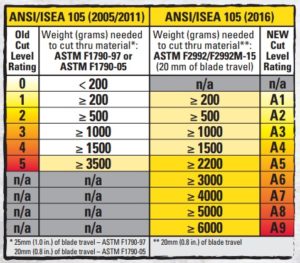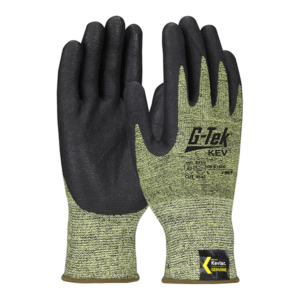How to Choose The Best Kevlar Gloves in 6 Simple Steps
Kevlar, a lightweight material five times stronger than steel, was discovered by a chemist Stephanie Kwolek half a century ago. Today, it is a component material used in numerous products ranging from protective vests and helmets to airplanes and cell phones. Per Scientific American, “Kevlar fiber has a density of 1.4 grams per cubic centimeter compared with iron's 7.9 grams per cubic centimeter … Offering strength under heat, Kevlar protects against thermal hazards up to 800 degrees Fahrenheit.” Although new versatile materials have emerged in recent years, some companies are still buying the same kind of Kevlar gloves that they’ve been using for many years. Kevlar has proven to be so dependable that experts predict it will be used for another fifty years.
Selecting the right pair of gloves can be challenging because protection requirements are different for different kinds of jobs. Here is your easy-to-implement 6-steps action plan which will help you find the appropriate hand protection solution faster.
6-Step Plan:
1. Choose between three basic types of Kevlar gloves| Type | Applications | Advantages | Disadvantages |
|---|---|---|---|
| Knitted Kevlar® gloves without coating | Commonly used in automotive industry and metal stamping | Perfect for handling large metal parts, sheet metal; easy-to-wash for a repeated use, cut-resistant | Dexterity is good, but not as great as in palm-coated gloves |
| Kevlar® Gloves with a palm coating | Perfect for a wide range of applications from parts assembly and work with electricity to construction | Great dexterity and grip for handling fine parts, cut protection; will not melt, ignite, or conduct electricity, cut-resistant | When coating wears out, the gloves should be replaced |
| Leather gloves with a Kevlar® lining, PVC palm | Applications include oil and gas industry and construction | Extremely durable, great abrasion resistance, flame- and cut-resistant | Dexterity is good, but not perfect, compared to palm-coated gloves |
2. Decide what cut-resistance level you need
The latest cut-resistance levels defined according to the new ANSI/ISEA standards were explained in the previous blog post: Understanding the New ANSI/ISEA 105 (2016) Hand and Arm Protection Cut Level Classification. Check it out - it should help you select the right cut resistance level of protective gloves required for your job.
3. Identify additional hazards you’ll be exposed to on the job: chemicals, extensive heat, and puncture
While finding the right glove to protect you from the multiple workplace hazards can be challenging, the protective gloves that will be effective against multiple threats do exist. The biggest trade-off, however, might be losing some dexterity.
4. Determine if 100% Kevlar or composite Kevlar is more beneficial for your application
The higher level of cut protection can be achieved by using the high-performance material, like Kevlar, and composite yarns made with fiberglass, steel, or synthetic materials, as well as by increasing weight of the material measured in ounces per square yard. Composite gloves typically provide higher cut resistance and better abrasion resistance compared to 100% Kevlar gloves and are often cost-saving alternative solutions.
5. Evaluate Durability
Durability is a critically important feature in a glove. To save cost, requesting a glove sample is a good idea. You can do a glove trial to evaluate durability and workers’ glove style preferences.
6. Prioritize comfort
Even if you chose a glove with the highest cut level and durability, if it does not provide some comfort while performing the job, your employees are not going to wear it. Making comfort a priority will help you make sure you are wearing the best gloves possible for your application.
Here are a couple suggestions for the following applications: material handling, general assembly, sanitation, general maintenance, woodworking, waste handling, fishing industries, recycling:

G-Tek® KEV™ Seamless Knit Kevlar® Blended gloves 09-K1618 with Nitrile-coated foam grip on palm and fingers. Key features: seamless knit construction provides comfort without sacrificing dexterity; gray 18 gauge shell for maximum dexterity; Kevlar® fiber is inherently cut resistant and will not melt, ignite or conduct electricity; foam nitrile coatings are compatible with light oils, and will provide excellent grip and abrasion resistance; touch screen capability allows users to operate any touchscreen device without removing gloves; knit wrist prevents dirt and debris from entering inside the glove. Performance properties: ANSI Cut Level A3 (Adopted by ANSI/ISEA 02/16), ABRASION 4, CUT 4, TEAR 2, PUNCTURE 1.
Want even stronger gloves? Check out G-Tek® KEV™ Seamless Knit Kevlar® Blended gloves 09-K1600 with Nitrile-coated foam grip on palm and fingers, 13 gauge shell, made with engineered yarn (Kevlar/Nylon/Steel Fiber), which are also touchscreen compatible. Performance properties: ANSI Cut Level A7 (Adopted by ANSI/ISEA 02/16), ABRASION 4, CUT 5, TEAR 3, PUNCTURE 2.
What Makes These Two Styles of Gloves So Special?
They have a touch screen capability and excellent dexterity paired with superior durability and high cut resistance.
Need new gloves? Take your time, do your research, and if you have any questions, call our product experts at 800-829-9580. Hopefully, this article will be helpful, too.
Recent Posts
-
Promoting Safety: National Work Zone Awareness Week is April 15-19, 2024
Each year, the National Work Zone Awareness Week (NWZAW) places the spotlight on the importance o …Apr 11th 2024 -
Understanding 4 Gas Monitors: How They Work & Why They Are Important
In today’s increasingly dynamic industrial landscape, 4 gas monitors have emerged as critical com …Apr 8th 2024 -
April Showers Require Workers to Wear Hi-Vis Safety Rain Gear
While April showers bring May flowers, they also bring challenges, particularly for those working …Apr 1st 2024







